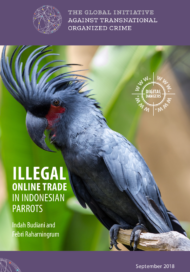Posted on 11 Sep 2024
The Indonesian islands of Bangka and Belitung have come under the spotlight for illegal tin mining, linked to what is potentially one of the biggest corruption scandals in the country’s history.
According to an investigation by the Indonesian attorney general’s office, PT Timah TBK – a state-owned tin mining company and among the world’s largest producers of refined tin – allegedly facilitated illegal mining activities in Bangka and Belitung between 2015 and 2022. The mining is reported to have caused environmental damage amounting to an estimated US$16.8 billion, according to an expert from Indonesia’s Bogor Agricultural University. As PT Timah essentially controls tin mining on these islands, the case could provide insight into widespread illicit practices in the sector.
A history of environmental destruction
Tin is primarily used as a component in electronics. Rapid technological advances have meant that it is in high demand globally, making it essential that its extraction is well regulated. Indonesia is the world’s largest producer of tin after China, with 90% of supply coming from mining operations concentrated in Bangka and Belitung.
The sector in Indonesia has long been dogged by allegations of corruption, illegality and environmental degradation. Illegal mining in Bangka and Belitung dates back to Dutch colonial rule, but has grown to the extent that by 2024, more than half of the area of these islands had been converted into tin mines, employing more than half of their population.
PT Timah alone is reported to have mined an area of 170 363 hectares on the two islands – almost double the area permitted under its mining concession. Many of the company’s illegal mining activities are reported to have occurred in areas that should have been off limits, including protected forest reserves and national parks.
Not surprisingly, this illegal mining has had a substantial impact on the environment. Open-pit mining in particular often involves heavy machinery and explosives, which generate large amounts of waste. This severely disrupts regional ecosystems and soil properties, rendering the landscape inhospitable to wildlife and native vegetation. Reclamation – the process of restoring disturbed land to a non-polluted state – is supposed to be a core activity of mining operations. However, official data shows that less than 10 per cent of land degraded by illegal mining in Bangka and Belitung was reclaimed by the government in 2023.
The massive environmental damage has also contributed to loss of plantations and the destruction of wildlife habitats on the islands. Incidents of crocodile attacks on humans have increased as mining operations push the animals closer to human settlements.
The role of corruption
In addition to the serious environmental damage, the PT Timah case stands out for the large scale of corruption allegedly involved. According to Indonesia newspaper Kompas, investigators from Indonesia’s attorney general’s office claim that PT Timah had leased smelters and purchased illegal tin materials without declaring these transactions. The profits were then reportedly funnelled through third parties to senior officials of PT Timah using fake transactions of smelting services and corporate social responsibility funds.
It is likely that corruption in illegal mining occurs throughout the supply chain – from informal miners bribing law enforcement officers to turn a blind eye, to police officers assisting in the trafficking of illegal tin abroad. In 2014, four Indonesian police officers were found on board a boat carrying 134 containers of illegally extracted tin from Bangka and Belitung to Singapore, suggesting that law enforcement officials are involved not only in the licensing process but also in illegal exports.
So far, prosecutors have named 21 people as suspects in the PT Timah case, including three government officials, all of them senior members of the mining office in Bangka and Belitung. They are suspected of authorizing the export of illegal tin from smelting companies, effectively giving the green light to their illicit operations. Senior executives from PT Timah are also among the suspects.
What’s next?
Despite the significant attention given to the case, media outlets have reported that illegal tin extraction continues in Bangka and Belitung under the protection of influential individuals. At this stage, all findings suggest that the PT Timah case is just the tip of the iceberg, and that the network of corruption and elite protection extends much further than what we currently know.
Going forward, prosecutors should also investigate the role of the central government and examine the possible involvement of law enforcement and military officials. An overhaul of the management of the mining industry in Indonesia is also urgently needed. The fact that PT Timah has been allowed to continue for nearly a decade suggests that the government does not have mechanisms in place to monitor either environmental crime and damages, or the corruption that is driving and facilitating illicit environmental economies.
Tackling tin mining corruption holistically would require a response from a number of government ministries and the anti-corruption commission, which should coordinate the investigative efforts of other government agencies. As a state-owned company, PT Timah is monitored by the ministry of state-owned enterprises, which should exercise its authority to investigate corrupt practices in the company. The ministry of energy and mineral resources, the overarching authority in Indonesia for monitoring and reporting on all aspects of mining operations, should order its investigators to scrutinize corrupt tin mining practices in Bangka and Belitung and other parts of Indonesia. The ministry of trade is already required by regulation to record all mining operations involving tin transactions, but a 2017 analysis by Indonesia Corruption Watch found that US$5.297 billion worth of tin exports had not been recorded. More effort therefore needs to be made to identify loopholes that can be exploited by rogue actors to continue mining and exporting tin illegally.
There are some positive developments on the horizon, with plans to incorporate tin into the government’s integrated information system (SIMBARA), which aims to improve governance and transparency in the mining sector. While the system is currently only operational for coal, its benefit is in allowing all processes – including tax payments, permit issuance and export records – to be carried out through a single system, making it easier to detect corruption.
Rolling out the system for tin could be a game changer for the sector, but the government cannot assume that once the system is online, corruption will automatically be eradicated. More effort will need to be made to identify loopholes that can be exploited by illicit actors to continue mining and exporting tin illegally. A multi-layered approach, inclusive of all stakeholders, is therefore essential.
This analysis is part of the ECO-SOLVE series of articles that aims to showcase solutions for monitoring and disrupting illicit environmental flows as well as strengthening international cooperation. ECO-SOLVE is a project implemented by the GI-TOC as part of the European Union’s Global Illicit Flows Programme.



